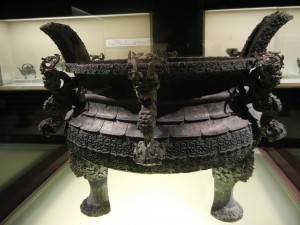Many things that you see in modern China have emerged from China’s deepest ancient thoughts.
The person paying respects at a shrine in Beijing is following patterns that were established over 3,000 years ago. We’ll explore a key concept behind them. It’s very deep, and uniquely Chinese.
The concept de has a wide range of meanings. Confucians have defined it as virtue. But the word is also closely associated with power. D. Howard Smith, in Chinese Religions, wrote that the oldest meaning of de was a potency, which gods, spirits and important people have. He compared it to mana–a psychic ability to do unusual things, which powerful beings and objects can have.
Smith wrote that during the Western Zhou Dynasty (1045-771BCE), de became associated with virtue–it made a king acceptable to Heaven (tian). Because he was virtuous, he could retain his power.
Not everyone agrees about the original meaning of de, but by the Zhou Dynasty, it did conflate power and virtue in a uniquely Chinese way. David Shepherd Nivison, in The Cambridge History of Ancient China, wrote that de’s meaning grew out of the sense of gratitude–if I do something nice for you, you feel compelled to do me a favor. I have de from you. This characterized the king’s relationship with the gods that he sacrificed to. If de originally meant psychic power, it acquired political and ethical meanings very early on. This idea helped the Western Zhou Dynasty achieve political unity.
So, a person who is generous and virtuous has a lot of psychic power to attract. Early Zhou kings consolidated their state with this idea. A king who sacrifices to the gods, and who gives to his subordinates acquires the most de. Kings and nobles exchanged bronze ritual vessels, like the one pictures above, in formal ceremonies. This solidified their bonds as the Zhou Dynasty extended its rule all over the Yellow and Yangtze rivers.
These bronze vessels thus became common symbols of unity throughout China. Civilization and harmony extended as far as these vessels were exchanged. We can note 3 key things that this tradition reveals about ancient Chinese thought:
1. Power, virtue, the civilized world, the state, and the gods are closely interwoven. The idea that became foundational in the Middle East, of a single god, who is transcendent and inexorably above all else, is very different. In China, the locus of power was not in one all-glorious god, but within the whole environment. Gods, kings and subjects possessed various amounts of de. Nobody had the whole cookie jar. The most basic reality is not one god, but harmony between all beings.
2. Power and virtue essentially circulate. The exchange of bronze vessels throughout the land became a model of reality–well-being is attained when power and goodness flow smoothly throughout the whole organism. This idea became foundational in medicine, and in ideas of yin and yang patterns.
3. Like Western linear models of reality, China’s ideas of reality as a smooth circular flow of power and virtue have many dimensions. The concept of de wasn’t its only root. You can read about another key idea, wind (feng).




Comments on this entry are closed.